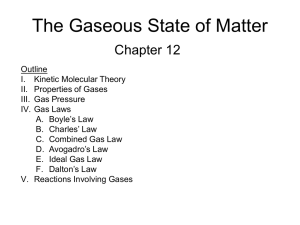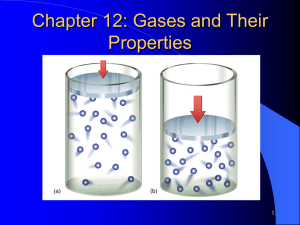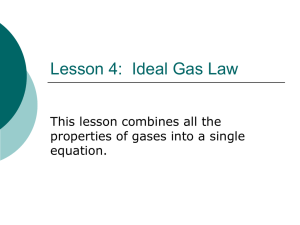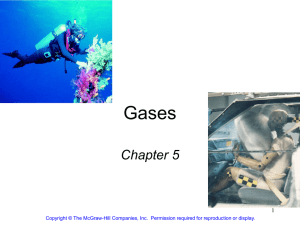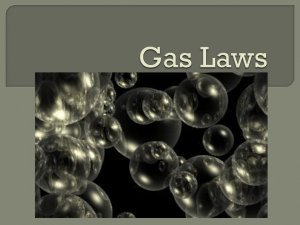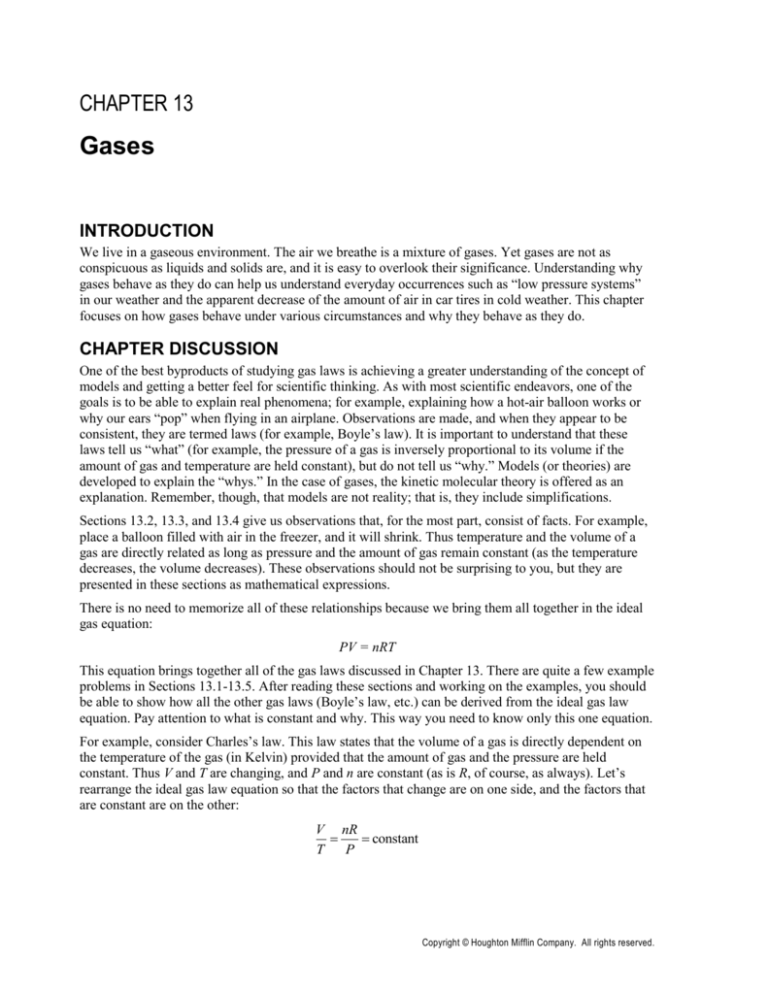
CHAPTER 13
Gases
INTRODUCTION
We live in a gaseous environment. The air we breathe is a mixture of gases. Yet gases are not as
conspicuous as liquids and solids are, and it is easy to overlook their significance. Understanding why
gases behave as they do can help us understand everyday occurrences such as “low pressure systems”
in our weather and the apparent decrease of the amount of air in car tires in cold weather. This chapter
focuses on how gases behave under various circumstances and why they behave as they do.
CHAPTER DISCUSSION
One of the best byproducts of studying gas laws is achieving a greater understanding of the concept of
models and getting a better feel for scientific thinking. As with most scientific endeavors, one of the
goals is to be able to explain real phenomena; for example, explaining how a hot-air balloon works or
why our ears “pop” when flying in an airplane. Observations are made, and when they appear to be
consistent, they are termed laws (for example, Boyle’s law). It is important to understand that these
laws tell us “what” (for example, the pressure of a gas is inversely proportional to its volume if the
amount of gas and temperature are held constant), but do not tell us “why.” Models (or theories) are
developed to explain the “whys.” In the case of gases, the kinetic molecular theory is offered as an
explanation. Remember, though, that models are not reality; that is, they include simplifications.
Sections 13.2, 13.3, and 13.4 give us observations that, for the most part, consist of facts. For example,
place a balloon filled with air in the freezer, and it will shrink. Thus temperature and the volume of a
gas are directly related as long as pressure and the amount of gas remain constant (as the temperature
decreases, the volume decreases). These observations should not be surprising to you, but they are
presented in these sections as mathematical expressions.
There is no need to memorize all of these relationships because we bring them all together in the ideal
gas equation:
PV = nRT
This equation brings together all of the gas laws discussed in Chapter 13. There are quite a few example
problems in Sections 13.1-13.5. After reading these sections and working on the examples, you should
be able to show how all the other gas laws (Boyle’s law, etc.) can be derived from the ideal gas law
equation. Pay attention to what is constant and why. This way you need to know only this one equation.
For example, consider Charles’s law. This law states that the volume of a gas is directly dependent on
the temperature of the gas (in Kelvin) provided that the amount of gas and the pressure are held
constant. Thus V and T are changing, and P and n are constant (as is R, of course, as always). Let’s
rearrange the ideal gas law equation so that the factors that change are on one side, and the factors that
are constant are on the other:
V nR
constant
T
P
Copyright © Houghton Mifflin Company. All rights reserved.
Chapter 13: Gases
Because R, P, and n are all constant, the factor “
119
nR
” must be constant as well. Therefore, we can write
P
this as
V nR
= constant
T
P
or
V
= constant
T
V
” is a constant, as long as P and n are held constant (and the
T
temperature is in Kelvin). We can rewrite this as
This shows us that the ratio “
V1 V2
T1 T2
which is the mathematical representation of Charles’s law you will find in Section 13.3 of your text.
You should spend some time and derive the other laws using this same approach.
These relationships explain what happens, but not why. To explain why, we need to consider a model
of gases. Section 13.6 in your text discusses Dalton’s law of partial pressures. Read through this section
and understand that this law is an observation; that is, it is a fact. The text also says that this law tells us
two important things about gases that are important enough to repeat here:
1.
The volume of the individual gas particle must not be very important.
2.
The forces among the particles must not be very important.
Make sure to understand how Dalton’s law of partial pressures tells us this. Discuss this with friends or
an instructor. These conclusions lead us to our model, the kinetic molecular theory (KMT).
The KMT is discussed in Section 13.8. Notice that two of the premises come from the above
conclusions, which come from observations. This is how model development works. That is, we make
observations and use the significance of these observations in developing a model. For example,
consider two of the assumptions in the KMT:
1.
The volume (size) of the individual particles can be assumed to be zero.
2.
The particles are assumed not to attract or to repel each other.
Note how these two premises are actually “ideal” cases that come from Dalton’s law of partial
pressures. That is, Dalton’s law of partial pressures leads us to believe that the volume of gas particles
is not important, nor are the forces among these particles. In the KMT, we assume that not only are
these factors not important, they are non-existent. Why do we do this? Because it is easier; that is, it
makes for a simpler model. And recall, our goal is to make the model as simple as we can as long as it
explains the observations we want it to explain.
You should strive to understand the significance of the KMT. Read through sections 13.8 and 13.9 and
make sure you can explain the relationships among pressure, volume, amount of gas, and temperature.
Copyright © Houghton Mifflin Company. All rights reserved.
120
Chapter 13: Gases
LEARNING REVIEW
1.
Gas in compressed gas cylinders is usually under a great deal of pressure. If the gas in a particular
cylinder has a pressure of 2500 psi, how many torr is this?
2.
Convert each of the units of pressure below.
3.
a.
0.408 atm to torr
b.
68,471 Pa to mm Hg
c.
50.9 psi to atm
The relationship observed by Boyle between volume and pressure is
a.
linear
b.
proportional
c.
inversely proportional
d.
no relationship
4.
Examine the cylinder with a moveable piston. If the piston moves downward, causing the volume
of the gas to decrease, will the pressure of the gas become larger or smaller?
5.
A sample of nitrogen gas at 2.4 atm has a volume of 50.3 L. If the pressure is decreased to 1.9
atm, will the new volume be greater or smaller? What is the new volume?
6.
Absolute zero is the temperature at which gases have zero volume. But zero volume has never
been measured in the laboratory. So how do we know at what temperature the volume of a gas
equals zero? Be as specific as possible.
7.
Which of the following equations cannot be derived from Charles’s law, V = bT?
a.
V
b
T
b.
V1 V2
T1 T2
c.
V1 V2
b
T1 T2
d.
3V
b
3T
8.
A container with a moveable piston contains 0.89 L methane gas at 100.5 °C. If the temperature of
the gas rises by 11.3 °C, what is the new volume of the gas?
9.
Avogadro’s law describes the relationship between the amount (number of moles) of a gas and the
volume of the gas. Under what conditions of temperature and pressure is Avogadro’s law true?
Copyright © Houghton Mifflin Company. All rights reserved.
Chapter 13: Gases
121
10. Where does the universal gas constant, R, come from?
11. Use the ideal gas law to solve the problems below.
a.
A sample of chlorine gas at 543 torr has a volume of 21.6 L. If the temperature of the
chlorine is 0 °C, how many moles of chlorine gas are present?
b.
Poisonous carbon monoxide gas is a product of the internal combustion engine. If 1.2 mol of
CO at 11°C and 102 mm Hg are present in a container, what will be the volume of the CO
gas?
c.
0.45 mol of a gas has a pressure of 299 torr at 300 °C and a volume of 53.8 L. At the same
temperature and pressure, the volume of the gas is decreased to 39.7 L. How many moles of
gas are present after the volume has changed?
12. Which statements about Dalton’s law of partial pressure are true and which are false?
a.
The total pressure (PTOTAL) of a mixture of gases is independent of the sizes of the gas
particles.
b.
Attractive forces between gas particles are important in determining PTOTAL.
c.
For ideal gases, PTOTAL depends solely on the total number of moles of gas for any
temperature and volume.
13. Assume that a sample of humid air contains only nitrogen gas, oxygen gas and water vapor. If the
atmospheric pressure is 745 mm Hg and the partial pressure of N2 is 566 mm Hg and of oxygen is
140. mm Hg, what is the partial pressure of water vapor in the air?
14. A 7.5-L mixture of gases is produced by mixing 4.0 L of N2 at 450 torr, 3.5 L of O2 at 252 torr,
and 0.21 L of CO2 at 150 torr. If the temperature is held constant at 65°C, what is the total
pressure of the mixture?
15. Explain the difference between a law and a model.
16. Which statements about the Kinetic Molecular Theory are true, and which are false?
a.
The postulates of the Kinetic Molecular Theory are true for all gases at all temperatures and
pressures.
b.
Gas particles are assumed to either attract or repel each other.
c.
The distance between individual gas particles is much greater than the volume of an
individual gas particle.
d.
As the Kelvin temperature of a gas increases, the average kinetic energy increases.
17. According to the Kinetic Molecular Theory, what are we measuring when we measure the
temperature of a gas?
18. Carbon dioxide is produced during the combustion of liquid propane fuel.
C3H8 + 5O2 3CO2 + 4H2O
If 5.0 kg of propane are burned at 1.000 atm pressure and 400.°C, what volume of CO2 gas is
produced?
19. A sample of fluorine gas has a volume of 19.9 L at STP. How many moles of fluorine are in the
sample?
Copyright © Houghton Mifflin Company. All rights reserved.
122
Chapter 13: Gases
ANSWERS TO LEARNING REVIEW
1.
There is no conversion factor directly between psi and torr. However, we can convert psi to atm
and atm to torr.
2500 psi
1.000 atm 760.00 torr
1.3 105 torr
14.69 psi 1.000 atm
2.
a.
0.408 atm ×
760.0 torr
= 310. torr
1.000 atm
b.
68471 Pa ×
1.000atm 760.0 mm Hg
= 513.6 mm Hg
101,325 Pa
1.000 atm
c.
50.9 psi ×
1.000 atm
= 3.46 atm
14.69 psi
3.
Boyle observed that as the volume increased, the pressure decreased. Pressure and volume are
inversely proportional. The correct answer is c.
4.
If the volume of gas inside the cylinder becomes smaller, then the pressure of the gas will become
larger.
5.
This problem provides pressure and volume data. Boyle’s law relates pressure to volume. We can
use P1V1 = P2V2, which is one way of writing Boyle’s law, to solve this problem. In this equation,
P1 and V1 represent initial, or starting, conditions. P2 and V2 represent final or changed conditions.
2.4 atm is the initial pressure, P1, and 50.3 L is the initial volume, V1. Pressure has changed so P2
is 1.9 atm, and we are asked for the new volume, V2. First, will the new volume be larger or
smaller? The pressure decreases from 2.4 atm to 1.9 atm. There is an inverse relationship between
temperature and pressure, so if the pressure decreases, we would expect the volume to increase.
Rearrange the equation to isolate V2 on one side.
P1V1 = P2V2
V1
P1
P
V2 2
P2
P2
V2 V1
P1
P2
Now substitute values into the equation.
V2 = 50.3 L ×
2.4 atm
1.9 atm
V2 = 64 L N2
This answer makes sense. The pressure has decreased from 2.4 atm to 1.9 atm, so we would
expect the volume to increase. The volume has in fact increased from 50.3 L to 64 L. There is an
inverse relationship between pressure and volume.
Copyright © Houghton Mifflin Company. All rights reserved.
Chapter 13: Gases
6.
123
We can measure the volume of a gas at various temperatures, some of which are very cold but not
quite absolute zero. We can then plot on a graph each temperature and volume pair.
Although we cannot measure the volume of a gas at −273.2 °C, we can determine at what
temperature the volume would be zero by drawing a continuation of the straight line of the graph
and noting where the temperature axis hits the line. This has been done for many different gases,
and the result is always the same; the temperature at which the volume of a gas would be zero is
−273.2°C.
7.
a.
Charles’s law can be written as V = bT, where V is volume, T is temperature and b is a
constant. We can rearrange the equation by dividing both sides by T.
V
T
b
T
T
b
So,
V
b can be derived from Charles’s law.
T
V1
V
V V
b and 2 b , then it is also true that 1 2 , so this relationship can also be
T1
T1 T2
T2
derived from V = bT.
b.
If
c.
We know that
and
d.
V
T
V1
V
V V
V
b and that 2 b . We also know that 1 2 , but we cannot add 1
T1
T1 T2
T2
T1
V2
together to equal the constant b. So this relationship cannot be derived from V = bT.
T2
By multiplying temperature and volume by the same value, we are not changing the
3V
V
equation, because
and
are both equal to the constant b.
3T
T
3V
V
b
3T
T
so this relationship can also be derived from V
Copyright © Houghton Mifflin Company. All rights reserved.
b
.
T
124
8.
Chapter 13: Gases
This problem provides temperature and volume data and asks about the volume of methane gas
when the temperature changes. We can use Charles’s law to solve the problem. One form of
Charles’s law is
V1 V2
T1 T2
The initial volume of methane is 0.89 L, and the initial temperature is 100.5 °C. The rise in
temperature is 11.3 °C, so the final temperature is the sum of 100.5 °C plus 11.3 °C, or 111.8 °C.
The unknown quantity is the final volume, V2. Rearrange the equation to isolate V2 on one side.
V1 V2
T1 T2
V1
T2
T
V2 2
T1
T2
V2 V1
T2
T1
Because both the initial and final temperatures are given in °C, we must convert to Kelvin.
initial temperature (T1)
TK = T°C + 273
TK = 100.5 + 273
TK = 374
final temperature (T2)
TK = 111.8 + 273
TK = 385
Now substitute values into the equation.
V2 = 0.89 L methane ×
385 K
374 K
V2 = 0.92 L methane
This answer makes sense. The temperature has increased, so the volume should also increase.
There is a direct relationship between the temperature in Kelvin of a gas and its volume.
9.
Avogadro’s law, which expresses a relationship between the volume of a gas and the number of
moles of that gas, is true only when the gas temperature and pressure are constant.
10. When the three laws that relate volume to pressure, to temperature and to the number of moles are
combined, the constants that are present in each individual law are combined into one constant,
called R, the universal gas constant. When volume is expressed in liters, pressure in atmospheres,
and temperature in Kelvin, R has units of L·atm/K·mol and a value of 0.08206 L atm/K mol.
11. The ideal gas law can be expressed as PV = nRT. Remember that temperature must be expressed
in kelvins, pressure in atmospheres, and volume in liters. If any of the quantities given in the
problem are expressed in other units, we must convert them before we can use the ideal gas law.
Copyright © Houghton Mifflin Company. All rights reserved.
Chapter 13: Gases
a.
125
This problem provides the pressure of chlorine gas in torr and the temperature in °C. Before
we proceed let’s convert torr to atmosphere and °C to K.
543 torr
1.000 atm
0.714 atm
760.0 torr
TK = T°C + 273
TK = 0 + 273
TK = 273
We are provided with pressure, volume, and temperature data, and we are asked for the
number of moles. Rearrange the ideal gas law equation to isolate n on one side.
PV = nRT
PV
RT
n
RT
RT
n
PV
RT
Now substitute values into the equation.
n
(0.714 atm)(21.6 L Cl2 )
(0.08206 L atm/K mol)(273 K)
n = 0.688 mol Cl2
b.
This problem asks us to calculate the volume of carbon monoxide gas, CO, given
temperature, pressure and the number of moles of gas. The pressure of CO is given in mm
Hg and temperature in °C. Before we proceed, we need to convert mm Hg to atmospheres
and °C to K.
102 mm Hg ×
1.000 atm
= 0.134 atm
760.0 mm Hg
TK = T°C + 273
TK = 11 + 273
TK = 284
We can use the ideal gas law to solve this problem because we are provided with
temperature, pressure and the number of moles of gas. Rearrange the ideal gas law to isolate
V on one side.
PV = nRT
V
P nRT
P
P
V
Copyright © Houghton Mifflin Company. All rights reserved.
nRT
P
126
Chapter 13: Gases
Now substitute values into the equation.
V
(1.2 mol)(0.08206 L atm/mol K)(284 K)
(0.134 atm)
V = 210 L CO
c.
In this problem we are provided with information about two different gases. The information
about the first gas is complete. That is, we know the number of moles, the temperature, the
volume and the pressure of the gas. We know the temperature, the volume and pressure of
the second gas and are asked to calculate the number of moles, n. We could use Avogadro’s
law, which relates volume and moles, to solve this problem, but we are asked to use the ideal
gas law. Because we know the temperature and the volume and the pressure of the second
gas, we can use the ideal gas law to calculate the number of moles. First convert pressure,
which is given in torr, to atm and temperature, which is given in °C, to K.
1.000 atm
0.393 atm
760.0 torr
299 torr ×
TK = TC + 273
TK = 300. + 273
TK = 573
Rearrange the ideal gas law to isolate n on one side.
PV = nRT
PV
RT
n
RT
RT
n
PV
RT
Now substitute values into the equation.
n=
(0.393 atm)(39.7 L)
(0.08206 L atm/mol K)(573 K)
n = 0.332 mol
12.
a.
The total pressure (PTOTAL) depends on only the total quantity of gas, not on the kind and
size of the particles. So this statement is true.
b.
Because PTOTAL does not depend on the identity of the gas particles but only on the quantity
of particles, this statement is false.
c.
The pressure of a single gas or a mixture of gases depends on the number of moles, and also
the temperature and volume. A mixture of gases follows the ideal gas law, just as a single
gas does. So this statement is false.
Copyright © Houghton Mifflin Company. All rights reserved.
Chapter 13: Gases
127
13. PTOTAL represents the pressure exerted by the gases in the atmosphere, which in this case is equal
to 745 mm Hg. PTOTAL equals POXYGEN + PNITROGEN + PWATER VAPOR. The two major components of
air are nitrogen and oxygen. If PNITROGEN equals 566 mm Hg, and POXYGEN equals 140. mm Hg,
then we can use the following equation to calculate PWATER VAPOR.
PTOTAL = POXYGEN + PNITROGEN + PWATER VAPOR
Rearrange the equation to isolate PWATER VAPOR on one side.
PWATER VAPOR = PTOTAL − (POXYGEN + PNITROGEN)
Now substitute values into the equation.
PWATER VAPOR = 745 mm Hg − (140. mm Hg + 566 Hg)
PWATER VAPOR = 39 mm Hg.
14. We are asked to calculate PTOTAL for a mixture of three gases. To determine PTOTAL, we need to
know the partial pressure of each individual gas. Calculating the partial pressure of any gas by
using the ideal gas law requires us to know the number of moles, n, of that gas. So we need to find
a way to calculate n. We are given the initial volume of each gas, the initial pressure, and the
PV
initial temperature, so we can use the ideal gas law in the form n
to find the number of
RT
moles. Because the number of moles of each gas does not change when the gases are mixed
together, we can use the value of n we calculated for each gas before they are mixed together to
calculate the partial pressure of each gas under the conditions present when the gases are mixed.
Because pressure is given in torr and temperature in °C, convert to atmospheres and Kelvin before
proceeding.
The temperature is held constant at 65 °C. Convert to atmospheres and Kelvin before proceeding.
TK = T°C + 273
TK = 65 + 273
TK = 338
For nitrogen
450 torr
nN 2
1.000 atm
0.59 atm
760.0 torr
(0.59 atm)(4.0 L N2 )
= 0.085 mol N2
(0.08206 L atm/mol K)(338 K)
For oxygen
252 torr
nO 2
1.000 atm
0.332 atm
760.0 torr
(0.332 atm)(3.5 L O2 )
= 0.042 mol O2
(0.08206 L atm/mol K)(338 K)
Copyright © Houghton Mifflin Company. All rights reserved.
128
Chapter 13: Gases
For carbon dioxide
150 torr
nCO 2
1.000 atm
0.197 atm
760.0 torr
(0.197 atm)(0.21 L CO2 )
= 1.5 × 10–3 mol CO2
(0.08206 L atm/mol K)(338 K)
So now we know the number of moles of each gas. We can use the ideal gas law to calculate the
partial pressure of each gas. We will need to use the volume of the gas mixture, not the volume of
each individual gas. Use the ideal gas law with P isolated on one side.
P
PCO 2
nRT
V
PN 2
(0.085 mol N2 )(0.08206 L atm/mol K)(338 K)
= 0.31 atm
7.5 L
PO 2
(0.042 mol O2 )(0.08206 L atm/mol K)(338 K)
= 0.16 atm
7.5 L
(1.5 10-3 mol CO2 )(0.08206 L atm/mol K)(338 K)
= 5.5 × 10–3 atm
7.5 L
The total pressure, PTOTAL, can be calculated from
PTOTAL = 0.31 atm + 0.16 atm + 5.5 × 10−3 atm
PTOTAL = 0.48 atm
15. A law is a generalization about behavior that has been drawn from repeated observation about
nature. A model is a theory that attempts to explain why a certain behavior is observed.
16.
a.
False. Gases obey the postulates of the Kinetic Molecular Theory best at high temperatures
and/or high pressures. When these conditions are not met, gases can exhibit other kinds of
behavior.
b.
False. In postulate four of the Kinetic Molecular Theory it is assumed that gas particles
neither attract nor repel each other.
c.
True. In postulate two of the Kinetic Molecular Theory, it is assumed that individual gas
particles are very small compared to the distances between the particles.
d.
True. The kinetic energy of a gas is proportional to the kelvin temperature.
17. When we measure the temperature of a gas, we are actually measuring how fast the gas particles
are moving. Postulate five of the Kinetic Molecular Theory results from the observation that as
the temperature of a gas increases, the movement of gas particles increases.
Copyright © Houghton Mifflin Company. All rights reserved.
Chapter 13: Gases
129
18. This problem provides the pressure, the temperature and the quantity in kg of a sample of propane
gas. We are asked to find the volume of another gas, carbon dioxide, produced when propane
burns. We know some information about carbon dioxide. We know that the pressure is 1 atm and
the temperature is 400°C. If we knew the number of moles of carbon dioxide, we could use the
ideal gas law to calculate the volume of carbon dioxide.
PV = nRT
??
We know the mass of propane that reacts to form CO2, and we have a balanced equation, so we
can calculate the moles of carbon dioxide using the mole ratio from the balanced equation. But
first let’s calculate the number of moles of propane that are equivalent to 5.0 kg of propane.
5.0 kg C3H8
1000 g C3H8 1 mol C3H8
110 mol C3H8
1 kg C3H8
44.09 g C3H8
Now that we know the number of moles of propane, we can use the mole ratio to calculate the
moles of CO2 that would be produced. The balanced equation tells us that every mole of C3H8
3 mol CO2
produces 3 moles of CO2 so the correct mole ratio is
1 mol C3 H8
110 mol C3 H8
3 mol CO2
330 mol CO2
1 mol C3 H8
Now we know the number of moles of CO2, the pressure and the temperature, so we can use the
ideal gas law to calculate the volume. First isolate V on one side.
PV = nRT
P
nRT
V
P
P
V
nRT
P
Because the temperature is given in °C, we must convert to Kelvin.
TK = T°C + 273
TK = 400. + 273
TK = 673 K
Now substitute values into the equation.
V
(330 mol C3 H8 )(0.08206 L atm/mol K)(673 K)
(1.0 atm)
V = 1.8 × 104 L CO2
Copyright © Houghton Mifflin Company. All rights reserved.
130
Chapter 13: Gases
19. We can solve this problem two ways. In the first method we can use the ideal gas law because we
know the volume, the temperature and the pressure. Rearrange the equation to isolate moles on
one side.
PV = nRT
PV
RT
n
RT
RT
n
PV
RT
The fluorine gas is at STP, which means that the temperature is 0 °C, and the pressure is 1 atm.
We need to convert °C to Kelvin before we proceed.
TK = 0 + 273
TK = 273
Now substitute values into the equation.
nF2
(1.0 atm)(19.9 L)
(0.08206 L atm/mol K)(273 K)
nF2 0.888 mol
In the second method we can use the conversion 1 mol of an ideal gas = 22.4 liters of gas. This
conversion works only if the gas is at STP. In this problem we are told that the temperature and
pressure are at STP.
19.9 L F2
1.00 mol F2
0.888 mol F2
22.4 L F2
Both methods gave the same answer, but we can use only the second method when the
temperature is 0 °C (273 K) and the pressure is 1.00 atmosphere.
Copyright © Houghton Mifflin Company. All rights reserved.




